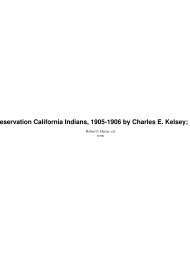The geography and dialects of the miwok indians - California Valley ...
The geography and dialects of the miwok indians - California Valley ...
The geography and dialects of the miwok indians - California Valley ...
Create successful ePaper yourself
Turn your PDF publications into a flip-book with our unique Google optimized e-Paper software.
UNIVERSITY OF CALIFORNIA PUBLICATIONSINAMERICAN ARCHAEOLOGY AND ETHNOLOGYVol. 6 Nos. 2 <strong>and</strong> 3THE GEOGRAPHY AND DIALECTS OF THEMIWOK INDIANSBYS . A. BARRETTON THE EVIDENCES OF THE OCCUPATION-OF CERTAIN REGIONS BYTHE MIWOK INDIANSBYA. L. KROEBERBERKELEYTHE UNIVERSITY PRESSFEBRUARY, 1908
UNIVERSITY OF CALIFORNIA PUBLICATIONSINAMERICAN ARCHAEOLOGY AND ETHNOLOGYVOL. 6 No. 3ON THE EVIDENCES OF THE OCCUPATIONOF CERTAIN REGIONS BY THEMIWOK INDIANSBYA. L. KROEBER.Since Mr. Barrett's paper on <strong>the</strong> Geography <strong>and</strong> Dialects <strong>of</strong><strong>the</strong> Miwok Indians was sent to press <strong>and</strong> announced, but previousto its publication, <strong>the</strong>re has appeared an article on <strong>the</strong> same subjectby Dr. C. Hart Merriam.' While <strong>the</strong>se two contributions,which were made entirely independently, corroborate each o<strong>the</strong>rclosely in <strong>the</strong> main, <strong>the</strong>y differ on certain points . <strong>The</strong>se differences,which relate in part to <strong>the</strong> territory <strong>of</strong> <strong>the</strong> Miwok stock asa whole, <strong>and</strong> in part to tribal <strong>and</strong> linguistic divisions, it hasseemed best to discuss briefly.As regards descriptions <strong>of</strong> <strong>the</strong> boundaries <strong>of</strong> <strong>the</strong> Miwok stock,Mr. Barrett <strong>and</strong> Dr . Merriam agree closely for <strong>the</strong> most part.Considering <strong>the</strong> impossibility <strong>of</strong> obtaining absolutely accurateinformation at a time when <strong>the</strong> Indians are much diminished innumbers, in certain regions entirely extinct, <strong>and</strong> <strong>of</strong>ten dispossessedfrom <strong>the</strong>ir native habitats ; considering also that one investigatorhas probably been able to carry inquiries far<strong>the</strong>r incertain sections <strong>and</strong> <strong>the</strong> o<strong>the</strong>r in o<strong>the</strong>r districts, <strong>and</strong> that in manyeases one describes a boundary more in detail <strong>and</strong> <strong>the</strong> o<strong>the</strong>r summarily; <strong>the</strong> agreement <strong>of</strong> <strong>the</strong>ir conclusions as regards <strong>the</strong> greaterpart <strong>of</strong> <strong>the</strong> Miwok territory is so close as to be strictly corroborative.In one region, however, <strong>the</strong> differences are considerable<strong>and</strong> important. Mr. Barrett assigns to <strong>the</strong> Miwok no part <strong>of</strong> <strong>the</strong>1 Distribution <strong>and</strong> Classification <strong>of</strong> <strong>the</strong> Mewan Stock <strong>of</strong> <strong>California</strong>, Amer.Anthr., n. s., IX, 338-357, with map, p1. XXV.
370 University <strong>of</strong> <strong>California</strong> Publications in Am. Arch. <strong>and</strong> Ethn. [Vol . 6San Joaquin-Sacramento valley proper except <strong>the</strong> district betweenCosumnes <strong>and</strong> Calaveras rivers, extending to <strong>the</strong> Sacramentodelta. Dr. Merriam adds to this territory a considerable regionbetween <strong>the</strong> lower Sacramento <strong>and</strong> Cosumnes, a strip on <strong>the</strong> lowerSan Joaquin <strong>and</strong> in <strong>the</strong> Sacramento delta, <strong>the</strong> entire valley east<strong>of</strong> <strong>the</strong> San Joaquin between Tuolumne <strong>and</strong> Calaveras rivers, <strong>and</strong><strong>the</strong> territory west <strong>of</strong> <strong>the</strong> lower San Joaquin as far toward <strong>the</strong>coast as Mt. Diablo. Such a wide discrepancy on <strong>the</strong> part <strong>of</strong>contemporary investigators is explainable only by <strong>the</strong> scantiness<strong>of</strong> available information, due to <strong>the</strong> almost total extinction <strong>of</strong><strong>the</strong> former inhabitants <strong>of</strong> <strong>the</strong> valley districts in question.Dr. Merriam on <strong>the</strong> authority <strong>of</strong> one informant expresslycounts <strong>the</strong> Chilumne <strong>of</strong> <strong>the</strong> east bank <strong>of</strong> <strong>the</strong> San Joaquin, justnorth <strong>of</strong> Stockton, as Miwok . All o<strong>the</strong>r evidence points to <strong>the</strong>irhaving been <strong>of</strong> <strong>the</strong> Yokuts family. <strong>The</strong> Bureau <strong>of</strong> AmericanEthnology, both in its earlier <strong>and</strong> more recent map <strong>of</strong> <strong>the</strong> linguisticstocks <strong>of</strong> North America, assigns this area to <strong>the</strong> Yokuts . InPowell's paper <strong>of</strong> 1891, as well as in <strong>the</strong> " H<strong>and</strong>book <strong>of</strong> AmericanIndians," <strong>the</strong>se people, following earlier authors, such as Chainisso,are called Cholovone ; but <strong>the</strong>se sources say nothing <strong>of</strong> <strong>the</strong>linguistic affinities <strong>of</strong> <strong>the</strong> Cholovone that enables <strong>the</strong>ir being positivelyplaced in any family. <strong>The</strong> material on which <strong>the</strong> Bureauhas classified <strong>the</strong>m as Yokuts (Mariposan) has not been published,nor is it known whe<strong>the</strong>r Messrs. Henshaw <strong>and</strong> Curtain obtainedany information regarding <strong>the</strong>m, but a Cholovone manuscriptby A. Pinart is referred to. This is probably <strong>the</strong> same as anarticle entitled " Etudes sur les Indiens Californiens : Sur lesTcholovones de Chorris," published in some source unknown to<strong>the</strong> author, <strong>and</strong> with which he is acquainted only through a separate(paged 79-87) in <strong>the</strong> possession <strong>of</strong> Dr . R. B. Dixon. M.Pinart in this paper gives a vocabulary which is pure Yokuts.22 Compare <strong>the</strong> following few selections : sky, tipxne ; moon, hopem ; atnight, toine ; rain, sheet ; water, ilikie ; rock, selel' ; egg, hon; wood, ites;extinguish (evidently imperative), shaap-ka ; <strong>the</strong> fire is out, shaap-inn-in(showing Yokuts intransitive <strong>and</strong> present-future suffix) . <strong>The</strong> last two pages(86 <strong>and</strong> 87) <strong>of</strong> <strong>the</strong> copy available seem to be from some o<strong>the</strong>r language.None <strong>of</strong> <strong>the</strong> terms are recognizable as Yokuts ; an r is used, which does notoccur in Yokuts or in <strong>the</strong> first part <strong>of</strong> <strong>the</strong> vocabulary ; names <strong>of</strong> tropicalanimals <strong>and</strong> plants are given ; <strong>and</strong> several translations in <strong>the</strong> first part <strong>of</strong> <strong>the</strong>vocabulary are repeated but in connection with different native terms .—Dr.Dixon suggests that <strong>the</strong> pamphlet may be from <strong>the</strong> Actes de la Societe Philologique<strong>of</strong> Paris, but like <strong>the</strong> author has no full set accessible from whichto verify this supposition .
1908] Kroeber.—Occupation <strong>of</strong> Certain Regions by Miwok Indians . 371He states that <strong>the</strong> Tcholovones, or better, olovomnes (Cholovomne),inhabited a rancheria situated nearly where to-day <strong>the</strong>town <strong>of</strong> Banta (Bantas) is. <strong>The</strong> o<strong>the</strong>r rancherias related to <strong>the</strong>Cholovomnes <strong>and</strong> speaking <strong>the</strong> same dialect were Jacikamne(Yachikamne), beside <strong>the</strong> town <strong>of</strong> Stockton ; Pasasamne (Pashashamne); Nututamne ; Tammukamne ; Helutamne ; Taniamne ;Sanaiamne ; Xosmitamne . 3 All <strong>the</strong>se rancherias were in SanJoaquin county. A little far<strong>the</strong>r up <strong>the</strong> San Joaquin river <strong>and</strong>on its affluents were <strong>the</strong> Lakkisamnes, <strong>the</strong> Notunamnes, <strong>and</strong> <strong>the</strong>Tuolumnes, 4 who spoke <strong>dialects</strong> very similar to <strong>the</strong> Yachikamne.M. Pinart 's vocabulary was obtained near Pleasanton (Plaranton)in 1880, from a woman called Maria, <strong>of</strong> Yachikamne origin.She stated that she was <strong>the</strong> last survivor <strong>of</strong> this rancheria ; <strong>and</strong>that she had also lived in <strong>the</strong> Cholovomne rancheria, which, however,had long since disappeared. <strong>The</strong> husb<strong>and</strong> <strong>of</strong> Maria, Philippede Jesus, was a Lakkisamne Indian, that is to say, from arancheria friendly <strong>and</strong> related to <strong>the</strong> Yachikamne. He corroborated<strong>the</strong> statements <strong>of</strong> his wife, adding that he also had inhabited<strong>the</strong> Cholovomne rancheria, <strong>and</strong> that <strong>the</strong> Indians <strong>of</strong> thisvillage did not differ in any way from <strong>the</strong> o<strong>the</strong>r Tulareno (Yokuts)Indians.In 1906 Jesus Oliver, near Ione, stated to <strong>the</strong> author that <strong>the</strong>people <strong>of</strong> <strong>the</strong> vicinity <strong>of</strong> Stockton were called Chulamni. Thisterm is evidently <strong>the</strong> same as Chilumne, <strong>and</strong> probably <strong>the</strong> sameas Cholovomne <strong>and</strong> Tcholovone . 5 He belonged to <strong>the</strong>se people,but owing to <strong>the</strong>ir extinction had mostly forgotten <strong>the</strong> language.<strong>The</strong> words <strong>and</strong> phrases he remembered are grammatically correctYokuts that would be understood by <strong>the</strong> Indians as far away asTule river reservation : ilik, water ; hites, wood ; hotol, fire ; ukunka,drink (imperative) ; hileu ma tanin, where are you going?It thus seems indubitable that a Yokuts-speaking body <strong>of</strong>Indians called by some form <strong>of</strong> <strong>the</strong> name Chulamni or Cholovomnelived in <strong>the</strong> plains on <strong>the</strong> lower San Joaquin in <strong>the</strong> vicinity<strong>of</strong> Stockton.' Cf. <strong>the</strong> Kosmitas <strong>of</strong> Chamisso in Kotzebue's Voyage, III, 51.' Cf. <strong>the</strong> Lakisumne <strong>and</strong> Fawalomne (for Tawalomnel), cited in Bancr<strong>of</strong>t,Native Races, I, 451.' Tchalabones <strong>and</strong> Tcholoones in Chamisso, loc. cit .
372 University <strong>of</strong> <strong>California</strong> Publications in Am . Arch. <strong>and</strong> Ethn . [Vol. 6It is not quite so well established that <strong>the</strong> remainder <strong>of</strong> <strong>the</strong>plains region, from Calaveras river south, was Yokuts. Bu<strong>the</strong>re too <strong>the</strong>re is evidence only <strong>of</strong> Yokuts, not <strong>of</strong> Miwok occupation.First <strong>of</strong> all <strong>the</strong>re are three short vocabularies obtained byMr. Barrett. One <strong>of</strong> <strong>the</strong>se is from an Indian called Wilson, atMerced Falls, given as <strong>the</strong> language <strong>of</strong> all <strong>the</strong> people that formerlylived below <strong>the</strong> edge <strong>of</strong> <strong>the</strong> foot-hills, in <strong>the</strong> open valley, asin <strong>the</strong> region <strong>of</strong> Snelling, <strong>and</strong> as far as Fresno.ilek, waterosit, fireluiku, eatokunk, drinktuiku, shootmoktco, old manThis is not only good Yokuts, but a dialect very similar toChauchila, as shown by <strong>the</strong> assimilation <strong>of</strong> <strong>the</strong> vowel <strong>of</strong> <strong>the</strong> imperativesuffix -ka to <strong>the</strong> stem vowel.<strong>The</strong> second vocabulary is from Charley Dorsey, at Sonora, <strong>and</strong>was said to be <strong>of</strong> <strong>the</strong> language <strong>of</strong> Lathrop, a town situated notfar from Stockton east <strong>of</strong> <strong>the</strong> San Joaquin.yet, onepodoi, twosopit, threesaat, eyeteli, teethsaba, mouthhosip, northhobotin, southdotu, eastlatsu, westtsupit, abovetuxil, belowhapil, earthilik, watersilel, rockuyits, woodkatciu, coyotepulubhal, manutubhai, chiefutub, greattooi, goodluika, eatukudka, drinkThis is good Yokuts <strong>of</strong> <strong>the</strong> nor<strong>the</strong>rn valley dialectic group,except that n <strong>and</strong> m have been throughout changed to d <strong>and</strong> b.This may have been an individual peculiarity . <strong>The</strong> verbal forms,like those in <strong>the</strong> preceding list, show <strong>the</strong> imperative suffix .
1908] Kroeber.—Occupation <strong>of</strong> Certain Regions by Miwok Indians . 373Some words from this informant have no known Yokuts oro<strong>the</strong>r equivalents:hupil, firetsubuk, smokesikel, ashesbokos, manzanitadutodil, persontelex, girlhapal, armtsowotse, fourkide, six<strong>The</strong> phonetic appearance <strong>of</strong> nearly all <strong>the</strong>se words is howeverYokuts. Abika, come here, <strong>and</strong> piska, tobacco (perhaps smoke),seem to show <strong>the</strong> Yokuts imperative ending -ka.Several o<strong>the</strong>r words seem to be Yokuts :tidela, world (attil-la, tkos, ear (tuk)tutas, l<strong>and</strong>) foot s (dadat, dadwatia,woman (water-ii, ate)girl) 7<strong>The</strong> third vocabulary is from Charley Gomez, a half-breedencountered by Mr. Barrett at Jamestown, <strong>and</strong> was said to be in<strong>the</strong> old language <strong>of</strong> <strong>the</strong> region about Knight's Ferry on <strong>the</strong> Stanislausriver, which is still his permanent home. This informanthad been previously stated by <strong>the</strong> before-mentioned Jesus Oliverto be <strong>the</strong> son <strong>of</strong> an old man <strong>of</strong> <strong>the</strong> Tawalimni tribe, some timedead, who had lived at Knight 's Ferry. Of <strong>the</strong> habitat <strong>and</strong>language <strong>of</strong> <strong>the</strong> Tawalimni Jesus had no certain knowledge . Hethought that <strong>the</strong>y may have lived west <strong>of</strong> <strong>the</strong> San Joaquin, perhapsopposite Stockton, <strong>and</strong> that <strong>the</strong> old man Gomez, <strong>and</strong> perhapso<strong>the</strong>rs, moved to Knight's Ferry from <strong>the</strong>ir original habitat.This is probably not <strong>the</strong> case, as <strong>the</strong> Tawalimni are evidently <strong>the</strong>Tuolumne, placed by Dr. Merriam in <strong>the</strong> valley between Stanislaus<strong>and</strong> Tuolumne rivers, <strong>and</strong> by M . Pinart, with o<strong>the</strong>r rancherias,far<strong>the</strong>r up <strong>the</strong> San Joaquin <strong>and</strong> on its tributaries, than <strong>the</strong>Yokuts villages in San Joaquin county . It is <strong>the</strong>refore morelikely that as stated by <strong>the</strong> informant Gomez himself to Mr . Barrett,<strong>the</strong> language is that <strong>of</strong> Knight's Ferry <strong>and</strong> <strong>the</strong> plains to <strong>the</strong>west.6 Coconoon ; Powers, Tribes <strong>of</strong> <strong>California</strong>, 575.r Calaveras County ; ibid., 573 .
374 University <strong>of</strong> <strong>California</strong> Publications in Am. Arch. <strong>and</strong> Ethn. [Vol . 6ilik, waterhotol, firetooi, gooduyetc, wooddotu, easttoxil, southhusiusu, northseele, rainluika, eathuyoska, st<strong>and</strong>puns, dogutubhai, chief<strong>The</strong>se are all Yokuts. <strong>The</strong> following belong to no knownlinguistic stock <strong>and</strong> probably rest in part on misunderst<strong>and</strong>ings :hate, h<strong>and</strong> (Miwok, hate,foot)hake, smoke (Miwok, ha-kisu)kawatc, pipehuti, tobaccoaiyisi, bluejaydapa, fa<strong>the</strong>raku, headhitcku, eyeasi, earuxu, nose (Costanoan us)ait, tongueus, nail (cf . nose)oyis, footkulo, arm (Miwok, koro,foot)<strong>The</strong>re is also <strong>the</strong> well known Yokuts vocabulary obtained byA. Taylor8 at Takin rancheria at Dent's ferry on Stanislaus river.This place must have been near <strong>the</strong> present Knight's Ferry, <strong>and</strong><strong>the</strong> dialect <strong>of</strong> <strong>the</strong> same rancheria may be represented by thisvocabulary <strong>and</strong> by <strong>the</strong> last.In <strong>the</strong> same connection may be mentioned <strong>the</strong> Coconoon Yokutsvocabulary from Merced river, collected by Adam Johnson<strong>and</strong> published in Schoolcraft <strong>and</strong> Powers.'Finally it is significant that Dr. Merriam places no Miwok in<strong>the</strong> plains region between <strong>the</strong> Tuolumne <strong>and</strong> <strong>the</strong> Fresno river,though this territory has in <strong>the</strong> past—on <strong>the</strong> statements <strong>of</strong> Powers<strong>and</strong> Powell <strong>and</strong> in <strong>the</strong> absence <strong>of</strong> information—always been assignedto <strong>the</strong>m. If <strong>the</strong>re were Yokuts here south <strong>of</strong> <strong>the</strong> Tuolumne,<strong>and</strong> Yokuts north <strong>of</strong> <strong>the</strong> Calaveras, <strong>the</strong> intervening region<strong>of</strong> <strong>the</strong> same physiographic character is less likely to have belongedto <strong>the</strong> Miwok.<strong>The</strong> great similarity <strong>and</strong> practical identity <strong>of</strong> <strong>the</strong> Chulamnidialect with <strong>the</strong> Yokuts <strong>dialects</strong> spoken on <strong>the</strong> lower Chowchilla,8 Reprinted from <strong>the</strong> <strong>California</strong> Farmer, XIII, 42, March 23, 1860, inPowers, Tribes <strong>of</strong> <strong>California</strong>, 570.' Schooleraft, IV, 413 ; Powers, 570 .
1908] Kroeber.—Occupation <strong>of</strong> Certain Regions by Miwok Indians . 375lower Fresno, <strong>and</strong> upper San Joaquin are also much easier tounderst<strong>and</strong> now that it seems that <strong>the</strong> Chulamni were not cut <strong>of</strong>ffrom <strong>the</strong>ir relatives by Miwok territory . In 1906 it was said : 1°"<strong>The</strong> language <strong>of</strong> <strong>the</strong> Chulamni shows <strong>the</strong>m undoubtedly to havebeen a very recent <strong>of</strong>fshoot from <strong>the</strong> main body <strong>of</strong> <strong>the</strong> Yokuts, "<strong>and</strong> in 1907 11 that " <strong>the</strong> isolated Chulamni <strong>of</strong> <strong>the</strong> region aboutStockton is known to have belonged " to <strong>the</strong> immediate sub-group<strong>of</strong> "Nor<strong>the</strong>rn <strong>dialects</strong> spoken in <strong>the</strong> plains" about Fresno <strong>and</strong>San Joaquin rivers . <strong>The</strong>se conditions are now explained by <strong>the</strong>continuity <strong>of</strong> Yokuts territory.In <strong>the</strong> face <strong>of</strong> this evidence, <strong>and</strong> <strong>the</strong> lack as yet <strong>of</strong> any specificmaterial such as vocabularies to <strong>the</strong> contrary, it seems that <strong>the</strong>whole valley east <strong>of</strong> <strong>the</strong> San Joaquin <strong>and</strong> south <strong>of</strong> <strong>the</strong> Calaveraswas Yokuts, <strong>and</strong> that <strong>the</strong> Miwok habitat on <strong>the</strong> plains was confinedto <strong>the</strong> region north <strong>of</strong> <strong>the</strong> Calaveras.<strong>The</strong> valley l<strong>and</strong> west <strong>of</strong> <strong>the</strong> San Joaquin may also have beenYokuts. On <strong>the</strong> maps <strong>of</strong> <strong>the</strong> Bureau <strong>of</strong> Ethnology <strong>and</strong> <strong>the</strong> University<strong>of</strong> <strong>California</strong> it has been assigned to <strong>the</strong> Costanoan family;but <strong>the</strong>re is no evidence known to <strong>the</strong> author in favor <strong>of</strong> such aview, o<strong>the</strong>r than <strong>the</strong> statements <strong>of</strong> certain <strong>of</strong> Mr . Barrett's informants.<strong>The</strong>re are several indications that <strong>the</strong> region in questionwas Yokuts. In <strong>the</strong> accepted Yokuts territory, both north<strong>and</strong> south <strong>of</strong> Tulare lake, <strong>the</strong>re were tribes, such as <strong>the</strong> Tulamni<strong>and</strong> Tachi, on <strong>the</strong> west as well as on <strong>the</strong> east side <strong>of</strong> <strong>the</strong> valley.M. Pinart's Cholovomne rancheria was at Banta, which is notfar from Tracy, near <strong>the</strong> westernmost arm <strong>of</strong> <strong>the</strong> San Joaquin<strong>and</strong> west <strong>of</strong> <strong>the</strong> main channel. Jesus Oliver believes that aTawalimni subsequently at Knight's Ferry came from <strong>the</strong> regionopposite Stockton ; however erroneous this view may be, it isprobably founded on a similarity <strong>of</strong> language in <strong>the</strong> two places.<strong>The</strong> Yachimesi, or Yaehichumne, mentioned as <strong>the</strong> original Indians<strong>of</strong> Stockton, 12 <strong>and</strong> stated in 1906 by Jesus to have beenat least near <strong>the</strong> site <strong>of</strong> <strong>the</strong> city, are put by Dr . Merriam west<strong>of</strong> <strong>the</strong> San Joaquin, between it <strong>and</strong> Mt . Diablo, which region is"Boas Anniversary Volume, 65.11 Present series <strong>of</strong> publications, II, 325.12 Cited in Bancr<strong>of</strong>t, Native Races, I, 452. See also <strong>the</strong> citation given byDr. Merriam, which places a village <strong>of</strong> <strong>the</strong> Yachekumnas on <strong>the</strong> site <strong>of</strong>Stockton, <strong>and</strong> <strong>the</strong> above-mentioned statement <strong>of</strong> M . Pinart to <strong>the</strong> same effect.
376 University <strong>of</strong> <strong>California</strong> Publications in Am. Arch. <strong>and</strong> Ethn . [Vol . 6also mentioned as <strong>the</strong>ir habitat by one <strong>of</strong> Bancr<strong>of</strong>t's informants . 13It would thus seem that <strong>the</strong> entire plain <strong>of</strong> <strong>the</strong> San Joaquin valleyfrom south to north, west as well as east <strong>of</strong> <strong>the</strong> central stream,was everywhere held by <strong>the</strong> Yokuts, a circumstance not suspecteduntil Mr. Barrett's investigation . However this may be, <strong>and</strong>whe<strong>the</strong>r <strong>the</strong> l<strong>and</strong> west <strong>of</strong> <strong>the</strong> lower San Joaquin was Yokuts orwhe<strong>the</strong>r it was Costanoan, it seems clear that it was not Miwok.On <strong>the</strong> eastern side <strong>of</strong> <strong>the</strong> Miwok territory, <strong>the</strong> difference betweenDr. Merriam's <strong>and</strong> Mr. Barrett's maps is only nominal,though at first appearance considerable. Dr. Merriam, it wouldseem, shows only territory permanently inhabited, <strong>and</strong> <strong>the</strong>reforeleaves <strong>the</strong> entire higher Sierra region blank. He does not statethat <strong>the</strong> entire western side <strong>of</strong> <strong>the</strong> higher Sierra above <strong>the</strong> Miwokfoothills was occupied by Shoshoneans or Washo. Mr. Barrettshows as Miwok all territory claimed by <strong>the</strong>m or used by <strong>the</strong>mduring <strong>the</strong> summer, <strong>and</strong> thus brings at least part <strong>of</strong> <strong>the</strong> easternboundary to <strong>the</strong> crest <strong>of</strong> <strong>the</strong> Sierra.On <strong>the</strong> second point, that <strong>of</strong> tribes <strong>and</strong> <strong>dialects</strong> within <strong>the</strong>Miwok family, <strong>the</strong>re is <strong>the</strong> same close agreement between Dr.Merriam <strong>and</strong> Mr. Barrett in <strong>the</strong> foothill region, <strong>and</strong> only <strong>the</strong>plains present differences <strong>of</strong> moment. <strong>The</strong> territory <strong>of</strong> <strong>the</strong>Nor<strong>the</strong>rn, Middle, <strong>and</strong> Sou<strong>the</strong>rn, or Amador, Tuolumne, <strong>and</strong>Mariposa, Miwok <strong>of</strong> both authors nearly coincides, <strong>and</strong> both makeidentical statements as to <strong>the</strong> practical unity <strong>of</strong> speech withineach <strong>of</strong> <strong>the</strong> three areas <strong>and</strong> <strong>the</strong> absence <strong>of</strong> any distinctive tribalor group names for <strong>the</strong> people <strong>of</strong> <strong>the</strong> three areas or <strong>dialects</strong>.In <strong>the</strong> valley Dr. Merriam distinguishes ten tribes, who he saysall spoke <strong>dialects</strong> <strong>of</strong> a common language, <strong>the</strong> Yatchachumne being<strong>the</strong> only one whose speech is somewhat doubtful . Of <strong>the</strong>se ten,Mr. Barrett <strong>and</strong> <strong>the</strong> author have given <strong>the</strong> Mokosumni, Mokelumni,<strong>and</strong> Ochekhamni as Miwok . 14 <strong>The</strong> Chulamni, Tuolumni,Yachikumni, <strong>and</strong> Dr. Merriam's Siakumne, 15 must be regardedas Yokuts. This leaves doubtful <strong>the</strong> affiliation <strong>of</strong> <strong>the</strong> Hulpoomne,<strong>the</strong> Wipa, <strong>and</strong> <strong>the</strong> Hannesuk. Judging only from <strong>the</strong>ir assigned" Ibid., from San Francisco Evening Bulletin, September 9, 1864."Am. Anthrop., n. s., VIII, 659, 662, 1906 . Ibid ., also Lelamni, Tawalimni,Sakayakiimni, Walalshimni . Except perhaps <strong>the</strong> Lelamni, <strong>the</strong>se areall mentioned by <strong>the</strong> informants cited by Bancr<strong>of</strong>t, 450-455." Also given in <strong>the</strong> citations by Bancr<strong>of</strong>t, ibid .
1908] Kroeber.—Occupation <strong>of</strong> Certain Regions by Miwok Indians . 377geographical position, <strong>the</strong> Hannesuk were probably Yokuts, <strong>the</strong>Hulpoomne 16 more likely Miwok than Yokuts. <strong>The</strong> territory inwhich Dr. Merriam places <strong>the</strong> Hulpoomne has generally beenconsidered Maidu.As regards <strong>the</strong> apparent tribes, each with its distinctive name,in <strong>the</strong> valley region, <strong>the</strong> question arises whe<strong>the</strong>r <strong>the</strong>se, at leastamong <strong>the</strong> Miwok, are not really only villages, as affirmed by Mr.Barrett.M. Pinart throughout speaks <strong>of</strong> <strong>the</strong> Cholovomne, <strong>the</strong> Yachikamne,<strong>the</strong> Tuolumne, <strong>and</strong> <strong>the</strong> o<strong>the</strong>r groups mentioned by him,as rancherias, <strong>and</strong> does not once use <strong>the</strong> word tribe . <strong>The</strong> Cholovomnes"inhabited a rancheria or village situated nearly where<strong>the</strong> town <strong>of</strong> Bantas is to-day." "<strong>The</strong> o<strong>the</strong>r rancherias relatedto <strong>the</strong> Cholovomnes <strong>and</strong> speaking <strong>the</strong> same dialect were <strong>the</strong> Yachikamne,beside Stockton ; <strong>the</strong> Pashashamne," etc. "All <strong>the</strong>serancherias were in San Joaquin county." "Far<strong>the</strong>r up . .were <strong>the</strong> Lakkisamnes," etc . "Baptism administered to individualsfrom this rancheria" (Cholovomne) . Maria, <strong>of</strong> Yachikamneorigin, claimed "to be <strong>the</strong> last survivor <strong>of</strong> her rancheria;"she had lived also "in <strong>the</strong> rancheria <strong>of</strong> <strong>the</strong> Cholovomnes." Herhusb<strong>and</strong> was "a Lakkisamne Indian, that is from a rancheriaallied <strong>and</strong> related to <strong>the</strong> Yachikumne ." And so on.<strong>The</strong> informant Jesus, when asked regarding <strong>the</strong> so-calledYachikumne, said that <strong>the</strong> word was not <strong>the</strong> name <strong>of</strong> a tribe but<strong>of</strong> a place, properly Yachik, near Stockton. Wana was ano<strong>the</strong>rinhabited site, a short distance below <strong>the</strong> steamer l<strong>and</strong>ing inStockton. He believed that it was to this place that his ownancestors, whom he called by <strong>the</strong> more general or tribal designationChulamni, belonged . Kui was a third site.Dr. Merriam himself speaks <strong>of</strong> several <strong>of</strong> his valley tribes asif <strong>the</strong>y were village groups, <strong>the</strong> Mokozumne being <strong>the</strong> only one <strong>of</strong>which he gives a number <strong>of</strong> villages . He mentions <strong>the</strong> "principalrancheria" <strong>of</strong> <strong>the</strong> Hulpoomne near Freeport ; <strong>the</strong> " principal village,Muk-kel (from which <strong>the</strong> tribe takes its name) " <strong>of</strong> <strong>the</strong>Mokalumne ; <strong>and</strong> "La-lum-ne, a rancheria near Clements" which"may be included under <strong>the</strong> Mokalumne tribe as its inhabitants"Mentioned as <strong>the</strong> Khoulpouni <strong>and</strong> Chulpun by Choris <strong>and</strong> Chamisso,cited ibid . <strong>The</strong> Hannesuk <strong>and</strong> Wipa do not seem to appear in any publishedlists .
378 University <strong>of</strong> <strong>California</strong> Publications in Am . Arch. <strong>and</strong> Ethn. [Vol . 6spoke <strong>the</strong> same language ." <strong>The</strong> Ochakumne he calls also Ochehakor Ochehakumne. Ochekh (Otcex) was obtained by Mr.Barrett as <strong>the</strong> name <strong>of</strong> a place. Hannesuk shows a similar ending.It seems likely that this term is literally <strong>the</strong> name not <strong>of</strong> abody <strong>of</strong> people but <strong>of</strong> <strong>the</strong>ir "principal village, " which was "on abig river."As all <strong>the</strong> evidence from this region bears out Mr . Barrett 'sstatement that -amni is a suffix applied to place or village namesto designate <strong>the</strong> inhabitants <strong>of</strong> such sites ; <strong>and</strong> as Dr. Merriamstates that all <strong>the</strong> tribes in question spoke <strong>dialects</strong> <strong>of</strong> a commonlanguage ; <strong>the</strong> conclusion seems warranted that all <strong>the</strong> Miwok <strong>of</strong><strong>the</strong> plains formed a single dialectic group in every way analogousto <strong>the</strong> nor<strong>the</strong>rn, central, <strong>and</strong> sou<strong>the</strong>rn dialectic groups <strong>of</strong> <strong>the</strong> foothills,<strong>and</strong> that <strong>the</strong> Mokosumni, Mokelumni, Ochehamni, <strong>and</strong> o<strong>the</strong>rs,instead <strong>of</strong> being co-ordinate with <strong>the</strong>se three larger groups,found <strong>the</strong>ir equivalents, in <strong>the</strong> foothill region, in such rancheriasas Award or Upusuni. In Mr. Barrett's <strong>and</strong> <strong>the</strong> author's terminology,<strong>the</strong> nor<strong>the</strong>rn, middle, <strong>and</strong> sou<strong>the</strong>rn "Mewuk" aredialectic divisions or dialect groups, each comprising a number<strong>of</strong> independent villages ; <strong>the</strong> valley " Mewko tribes," so far as<strong>the</strong>y are Miwok, are independent villages collectively formingone, <strong>and</strong> only one, dialectic group, which is exactly co-ordinatewith, for instance, <strong>the</strong> nor<strong>the</strong>rn foothill group.It must be admitted that <strong>the</strong> habit <strong>of</strong> <strong>the</strong> plains Miwok, <strong>of</strong>speaking not <strong>of</strong> Mokel but <strong>of</strong> Mokelumni, not <strong>of</strong> Ochekh but <strong>of</strong><strong>the</strong> Ochehamni, gives <strong>the</strong> impression that <strong>the</strong>re were in this regiontrue tribes. It is possible that intimate contact with <strong>the</strong> Yokuts,who so far as known were everywhere anomalous in possessing atrue tribal organization, may have somewhat modified <strong>the</strong> political<strong>and</strong> social organization <strong>of</strong> <strong>the</strong> plains Miwok in <strong>the</strong> same direction ;but it is necessary to distinguish carefully between actual evidence<strong>of</strong> an approach to tribal organization,—which is so far entirelylacking-<strong>and</strong> <strong>the</strong> mere appearance <strong>of</strong> such an organizationas produced by <strong>the</strong> plains Miwok use <strong>of</strong> a suffix meaning "people<strong>of</strong>." Every Yuki rancheria can in <strong>the</strong> same way be dignifiedinto a tribe by laying undue stress upon <strong>the</strong> suffix -nom, "people<strong>of</strong>," which can be added to its name, <strong>and</strong> by emphasizing <strong>the</strong> factthat <strong>the</strong> Yuki have a habit <strong>of</strong> mentioning more frequently <strong>the</strong>inhabitants <strong>of</strong> a place than <strong>the</strong> village itself . Such conditions
1908] Kroeber.—Occupation <strong>of</strong> Certain Regions by Miwok Indians . 379are matters <strong>of</strong> linguistic idiom, <strong>and</strong> we should exercise <strong>the</strong> greatestreluctance to deduce from <strong>the</strong>m, without fur<strong>the</strong>r direct evidence,any conclusions as to <strong>the</strong> actual organization <strong>of</strong> <strong>the</strong> people.It cannot be too <strong>of</strong>ten reaffirmed that <strong>the</strong> only safe rule to followin ethnological studies in <strong>California</strong> is invariably to assume, in<strong>the</strong> absence <strong>of</strong> positive information to <strong>the</strong> contrary, that <strong>the</strong> onlyactually existing units <strong>of</strong> organization are <strong>the</strong> village <strong>and</strong> <strong>the</strong>language or dialect, <strong>and</strong> that <strong>the</strong> tribe, in <strong>the</strong> ordinary sense <strong>of</strong><strong>the</strong> word, <strong>and</strong> as an intermediate division, is absent.<strong>The</strong> ending -amni, which thus seems to be at <strong>the</strong> bottom <strong>of</strong> <strong>the</strong>differences <strong>of</strong> view regarding <strong>the</strong> Miwok "tribes," appears to beused in this stock principally or only in <strong>the</strong> northwestern orvalley dialect. Mr. Barrett 's examples <strong>of</strong> its employment <strong>and</strong>significance are all from this dialect ; <strong>and</strong> all <strong>the</strong> Miwok groupsmentioned by any author <strong>and</strong> having names showing this suffix,are from <strong>the</strong> territory <strong>of</strong> this dialect. This fact goes to explainwhy "tribes" like those <strong>of</strong> <strong>the</strong> plains have not been alleged among<strong>the</strong> foothill Miwok.While <strong>the</strong> ending -amni is found among <strong>the</strong> Yokuts, its employmentby <strong>the</strong>m is different from that <strong>of</strong> <strong>the</strong> plains Miwok.It occurs on many tribal names, but is lacking from more, suchas Tachi, Yaudanchi, Gashowu, Pitkachi, Chauchila, Chukchansi,Choinok. <strong>The</strong> ending has no apparent meaning in Yokuts . Itssubtraction from names like Choinimni, Telamni, Chulamni,Yauelmani, Tulamni, usually leaves no words that have meaningto <strong>the</strong> Indians or that are stems identifiable by <strong>the</strong> linguisticstudent. <strong>The</strong> suffix cannot be added to names <strong>of</strong> places to formdesignations <strong>of</strong> people ; <strong>the</strong> people at Tishechu are <strong>the</strong> Choinimni,not <strong>the</strong> Tishechimni, a term that would probably not be understoodby <strong>the</strong> Yokuts. <strong>The</strong> universal Yokuts suffix that in itsusage <strong>and</strong> meaning is <strong>the</strong> exact equivalent <strong>of</strong> valley Miwok -amni,is -inin : as in Alt-inin, people <strong>of</strong> alit ; khomt-inin, sou<strong>the</strong>rners,people <strong>of</strong> khomot, south ; padu-unun, people below ; khosm-inin,nor<strong>the</strong>rners. <strong>The</strong> supposition may <strong>the</strong>refore be hazarded that <strong>the</strong>ending -amni is originally a Miwok ending, occurring at presentchiefly or only in <strong>the</strong> plains or northwestern dialect <strong>of</strong> <strong>the</strong> Sierraor main division <strong>of</strong> <strong>the</strong> stock, with <strong>the</strong> meaning " people <strong>of</strong> ; "that from this dialect its use spread, as an ending <strong>of</strong> tribal designations,to <strong>the</strong> adjacent but linguistically unrelated Yokuts,
380 University <strong>of</strong> <strong>California</strong> Publications in Am. Arch. <strong>and</strong> Ethn. [Vol . 6among whom however, except possibly in <strong>the</strong> region in immediatecontact with <strong>the</strong> plains Miwok, it did not remain a freely usablesuffix, but crystallized in certain tribal names ; <strong>and</strong> that it spreadin <strong>the</strong> opposite direction to <strong>the</strong> Maidu, among whom it occurs onseveral names <strong>of</strong> what have been designated villages.In <strong>the</strong> case <strong>of</strong> <strong>the</strong> nor<strong>the</strong>rnmost Yokuts, <strong>the</strong>re is some doubtregarding <strong>the</strong> use <strong>of</strong> <strong>the</strong> ending -amni. If all M. Pinart's namesare, as he says, village names, <strong>the</strong> stem <strong>of</strong> each word must havebeen used to denote <strong>the</strong> site <strong>of</strong> <strong>the</strong> village. It may be, however,that such names as Yachikamni are not Yokuts but Miwok formations,<strong>and</strong> that <strong>the</strong> Yokuts <strong>the</strong>mselves spoke only <strong>of</strong> Yachik,as one <strong>of</strong> <strong>the</strong> places inhabited by <strong>the</strong> Chulamni tribe . It is probablethat not all <strong>the</strong> extreme nor<strong>the</strong>rn Yokuts names given by M.Pinart <strong>and</strong> Dr. Merriam are co-ordinate in scope . <strong>The</strong>re aretoo many for <strong>the</strong>m all to have designated tribes equivalent to <strong>the</strong>tribes <strong>of</strong> <strong>the</strong> Yokuts far<strong>the</strong>r south, <strong>and</strong> M. Pinart's identification<strong>of</strong> <strong>the</strong>m with village-communities indicates that at least some <strong>of</strong><strong>the</strong> number were such. On <strong>the</strong> o<strong>the</strong>r h<strong>and</strong> <strong>the</strong> existence <strong>of</strong> distincttribes elsewhere among <strong>the</strong> Yokuts leads to a natural hesitanceto accept all <strong>the</strong>se names as only designations <strong>of</strong> villagecommunities,though such a departure from <strong>the</strong> normal Yokutsstatus might have been brought about by close association with<strong>the</strong> non-tribal plains Miwok.As regards Mr. Barrett's Marin or sou<strong>the</strong>rn coast Miwok, inplace <strong>of</strong> whom Dr. Merriam recognizes <strong>the</strong> Lekahtewutko <strong>and</strong> <strong>the</strong>Hookooeko, it is sufficient to say that Dr. Merriam states <strong>the</strong>language <strong>of</strong> <strong>the</strong> two divisions to be essentially <strong>the</strong> same, that <strong>the</strong>name <strong>of</strong> <strong>the</strong> Lekahtewutko is taken from Lekahtewut, 17 a rancherianear Petaluma, <strong>and</strong> that <strong>the</strong> name Hookooeko, which was notencountered by Mr. Barrett, is unexplained . It would seem<strong>the</strong>refore that in this region also a true but nameless unit <strong>of</strong> division,a homogeneous dialectic group, has been split <strong>and</strong> <strong>the</strong> tw<strong>of</strong>ragments more or less arbitrarily designated by terms which innative usage were <strong>the</strong> names only <strong>of</strong> single villages, comprised,with numerous o<strong>the</strong>rs, in a larger dialectic but non-tribal group.Berkeley, <strong>California</strong>,November 25, 1907.17Cited by Bancr<strong>of</strong>t, Native Races, I, 453, as <strong>the</strong> "Lecatuit tribe" <strong>of</strong>Marin county, <strong>and</strong> by Powers, 195, as <strong>the</strong> Likatuit .
Digitized byYosemite Online Libraryhttp ://www .yosemite .ca .us/librarDan Anderson




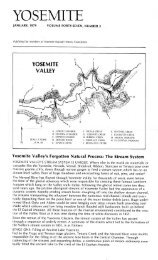
![(March 1982) [PDF] “We Are Pleased to Announce†- Yosemite Online](https://img.yumpu.com/51299748/1/190x242/march-1982-pdf-aeuroewe-are-pleased-to-announceaeur-yosemite-online.jpg?quality=85)
![[PDF] Old Horny, Yosemite's Unicorn Buck - Yosemite Online](https://img.yumpu.com/51269869/1/184x260/pdf-old-horny-yosemites-unicorn-buck-yosemite-online.jpg?quality=85)
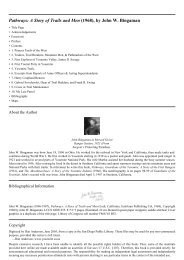
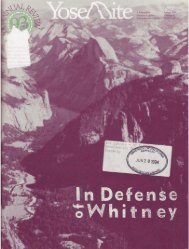
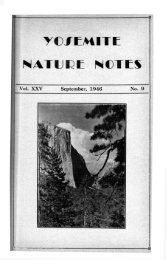
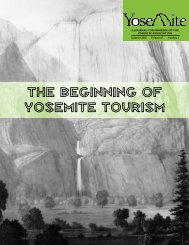
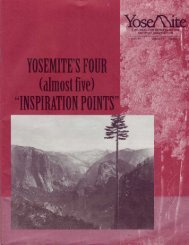
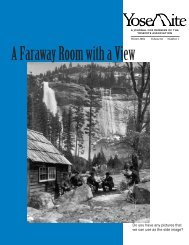
![1985 [PDF] - Yosemite](https://img.yumpu.com/48128837/1/184x260/1985-pdf-yosemite.jpg?quality=85)

